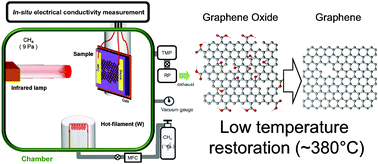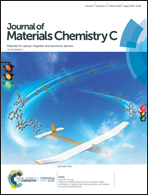Analysis of the low-temperature restoration process of graphene oxide based on in situ conductivity measurement†
Abstract
Graphene, a honeycomb network of sp2 carbon atoms, is expected to replace conventional materials in various fields, which makes it important to develop a high-throughput graphene synthesis method for industrial applications. Chemical exfoliation via graphene oxide (GO) is advantageous in terms of productivity; however, the low crystallinity of graphene converted from GO prevents this method from being widely used. Annealing in hydrocarbon or alcohol vapors at high temperatures around 1000 °C has been found to increase the crystallinity. Although this method was feasible, the reduction process has not yet been clarified, which makes it difficult to improve the crystallinity further and decrease the annealing temperature. Here, we constructed a new in situ conductivity measurement system with two independent heaters: one for heating GO and the other (hot filament) for cracking the CH4 molecule. We succeeded in changing GO into graphene at 380 °C using the hot filament and elucidated the reduction and restoration process by Raman spectroscopy and monitoring the change of conductivity. The etching of GO has been found to precede the restoration of the honeycomb lattice and the activation energy of the restoration was determined to be 0.9 eV, which was much lower than that in chemical vapor deposition. This basic knowledge of the reaction of GO will be helpful for synthesizing various materials from GO.



 Please wait while we load your content...
Please wait while we load your content...